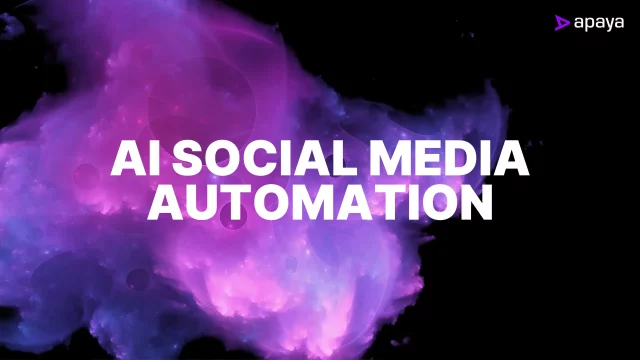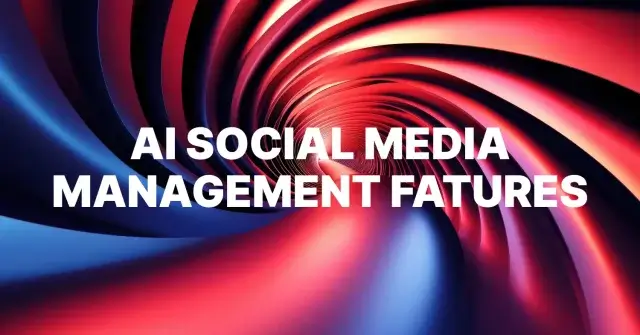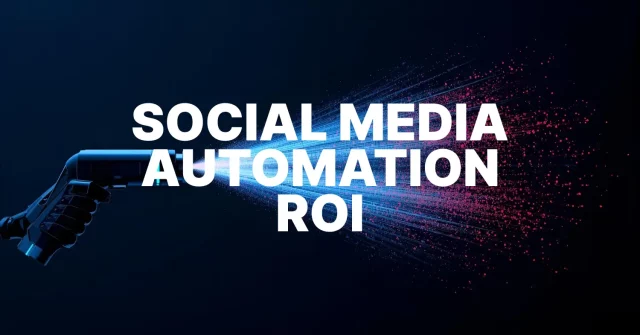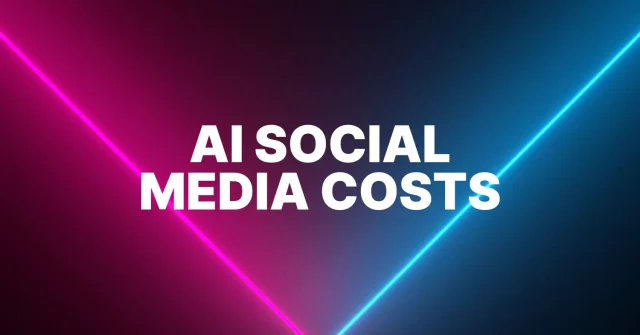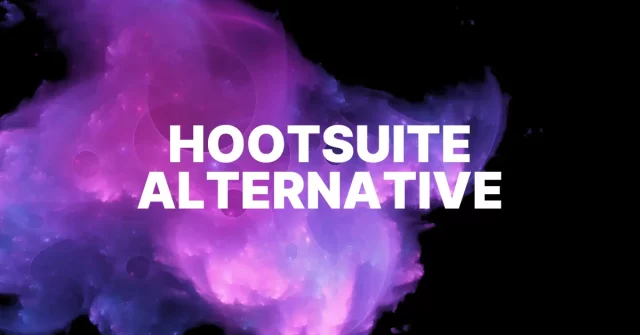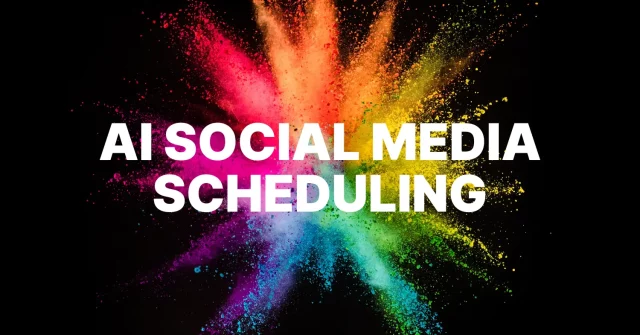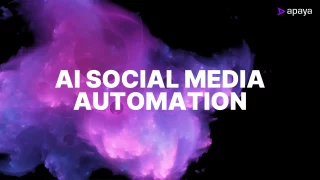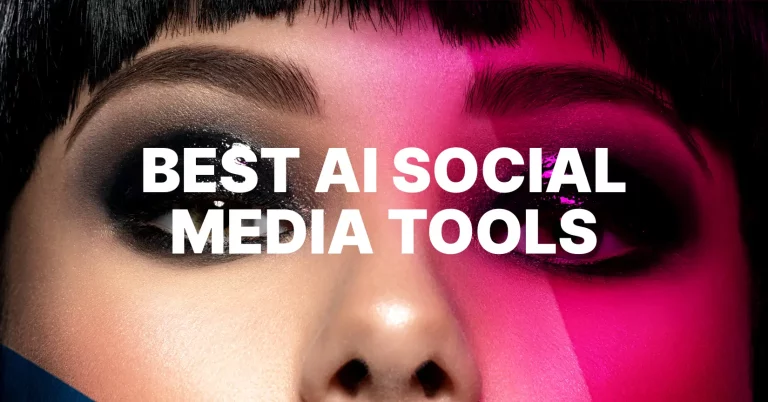
Best AI Social Media Tools. The Complete Evaluation Guide
Written by: Tim Eisenhauer
Last updated:

The best ai social media tools by category.
- Best Overall AI Social Media Tool: Apaya – Complete automation from content creation to publishing ($99-$249/month)
- Best for Enterprises: Sprout Social with AI features – Advanced analytics and team workflows ($249-$499/month)
- Best AI Writing Assistant: ChatGPT or Claude – Powerful text generation, requires separate scheduling ($20-$60/month)
- Best for Design: Canva with Magic Write – Templates plus basic AI, manual scheduling needed ($12-$120/month)
- Best Free Option: Buffer’s free plan with AI assistant – Limited to 3 channels, basic AI features ($0)
The landscape of AI social media tools has fundamentally changed in 2025. While traditional schedulers add AI features, true automation platforms now handle everything from content creation to performance optimization without daily management.
What Makes a Tool “AI-Powered”?
Not all “AI social media tools” are equal. Here’s the spectrum:
- Level 1 – AI-Assisted: Basic caption suggestions and hashtag recommendations (are hashtags even relevant anymore?)
- Level 2 – AI-Enhanced: Content generation with templates, some automation
- Level 3 – AI-Driven: Learns your brand, creates original content, requires approval
- Level 4 – AI-Autonomous: Complete automation from strategy to publishing
Most tools claiming “AI” are Level 1 or 2. Only a handful achieve true automation (Level 4), where the system runs independently while continuously learning and improving.
“The best way to predict the future is to invent it.”
– Alan Kay
I was sitting in my home office at 2 AM, manually scheduling posts for the fifth platform that week, when it hit me: I’d become a full-time social media secretary for my own business.
Three hours earlier, I’d started with a simple goal—schedule tomorrow’s posts. By midnight, I was still resizing images in Canva, rewriting captions for LinkedIn’s character limit, and trying to remember which hashtags worked on Instagram versus Twitter. My actual business? The thing that makes money? That could wait until tomorrow. Again.
The $50,000 mistake I made buying every social media tool.
Back in 2022, I went on what I now call my “tool bender.” Buffer for scheduling. Canva for design. ChatGPT for writing. Hootsuite for analytics. Later for Instagram. Sprout Social because someone said it was “enterprise-grade.”
My credit card statements looked like I was collecting social media tools like Pokémon cards. $47 here, $97 there, $297 for the “pro” version that would surely solve everything. Within six months, I’d blown over $50,000 on tools, courses, and “done-for-you” templates.
You know what I had to show for it? A prettier version of the same problem. I was still doing all the work, just with fancier dashboards.
The tools weren’t the problem. The entire approach was broken. I was trying to optimize a hamster wheel instead of stepping off it. These weren’t AI social media tools—they were expensive ways to do manual labor with a digital interface.
From schedulers to AI: The 4 generations of social media tools.
My expensive education taught me that social media tools have evolved through four distinct generations, and most businesses are stuck using yesterday’s technology for tomorrow’s problems.
Generation 1 (2008-2012): The scheduling revolution
Hootsuite and Buffer pioneered the radical idea that you could post to multiple platforms without logging into each one. Mind-blowing at the time. Problem was, you still had to create everything. These tools were basically digital clipboards—helpful, but hardly revolutionary.
Generation 2 (2013-2018): The analytics age
Sprout Social and Later added team workflows and basic analytics. Now you could see how badly your content was performing across multiple platforms simultaneously. Progress! You could collaborate with your team to create mediocre content faster than ever before.
Generation 3 (2019-2022): The template trap
Canva democratized design. Suddenly everyone could make graphics that looked professional. But looking professional and being effective are different things. We all just made prettier posts that still required hours of manual work. The hamster wheel got a fresh coat of paint.
Generation 4 (2023-2025): True AI automation
This is where everything changed. We’re talking about autonomous systems that actually think and create, not just follow rules. They learn your brand, generate original content, optimize timing, and improve performance—all without your input.
Types of AI Social Media Tools
AI social media management comes in many forms. Each type solves specific problems.
Content Creation AI
These tools generate posts from scratch. Give them a topic. They write captions, create images, and produce videos.
WriteSonic creates social media copy. Canva’s AI designs graphics. Synthesia makes videos with AI avatars. Each tool handles one piece of content creation.
The challenge? You need multiple tools. You pay for each separately. You learn different interfaces. You still coordinate everything manually.
Scheduling and Optimization AI
Smart scheduling goes beyond calendars. These AI tools analyze when your audience engages most. They test different posting times. They automatically adjust schedules based on performance.
Later uses AI for optimal timing. Sprout Social predicts engagement rates. They remove guesswork from posting schedules.
Analytics and Insights AI
Data means nothing without insights. AI analytics tools spot trends humans miss. They identify which content drives sales. They predict what will work next month.
Socialbakers tracks competitor performance. Brandwatch monitors sentiment across platforms. They turn data into actionable strategies.
Community Management AI
Responding to every comment takes hours. AI community tools handle routine interactions. They answer common questions. They flag important messages for human review.
Zendesk’s AI responds to customer queries. Sprinklr manages conversations at scale. They keep communities engaged 24/7.
The All-in-One Solution
Most businesses juggle 5-10 different tools. It’s expensive. It’s complicated. It’s inefficient.
Apaya combines all AI social media capabilities in one platform. Create content. Schedule intelligently. Analyze performance. Manage communities. Everything works together seamlessly.
The 7-point framework for evaluating AI social media tools in 2025.
After wasting fifty grand, I developed a framework for evaluating these tools. Use this to cut through the marketing BS and find what actually works.
1. Depth of automation: Does it actually save time?
Simple question: Can this tool run for a week without you touching it? If the answer is no, it’s not automation—it’s assisted manual labor. True automation means the system creates, schedules, and publishes without your daily input. Most “AI tools” fail this test immediately.
2. Brand learning capability: Does it sound like you?
Generic AI content is worse than no content. The tool needs to learn YOUR voice, not spit out templates. How does it learn? From your website, your existing content, your actual business—not from you filling out a 47-question brand survey. Modern LLMs can capture authentic brand voice, but only if they’re trained on your actual content, not generic prompts.
3. Content generation quality: Original or recycled?
Here’s a dirty secret: Most AI tools are using the same underlying models with slightly different prompts. The difference is in how they’re implemented. Can it create diverse content types? Design custom graphics? Adapt for different platforms? Or does every post feel like it came from the same boring template?
4. Intelligence and learning: Does it get smarter?
Static tools are dead tools. Your AI should track performance, identify patterns, and automatically adjust strategy. If it’s not learning from every post, you’re just using expensive automation for bad social media strategy.
5. ROI and time savings: The only metrics that matter
Forget vanity metrics. Calculate the actual ROI. How many hours does it save weekly? What’s your hourly rate? What’s the tool cost? If you’re not saving at least 10x the tool cost in time value, you’re wasting money.
6. Platform coverage: One tool or five?
Every additional tool is another login, another learning curve, another monthly charge. The best AI social media tools in 2025 handle all major platforms with proper formatting for each. No more copy-paste gymnastics.
7. Implementation reality: Days or months?
If it takes a month to set up, it’s not solving your problem—it’s creating a new one. Modern AI tools should be functional within hours, not weeks. Long implementation means complicated maintenance.
The state of AI social media tools in 2025: Four categories that matter.
After evaluating dozens of platforms, I’ve found they fall into four distinct categories. Understanding these helps you spot what you’re really buying.
Category 1: Legacy schedulers with AI lipstick
These are your Buffers and Hootsuites of the world, scrambling to add AI features to their 15-year-old architecture. They’ve bolted on AI writing assistants that suggest captions and hashtags. Helpful? Sure. Revolutionary? Hell no.
- What you get: Basic caption suggestions, hashtag recommendations, “optimal timing” based on generic data
- What you still do: Create all graphics, write most content, manage everything manually
- Monthly cost: $50-200
- Time saved: Maybe 2-3 hours per week
- Verdict: Like putting a Tesla battery in a horse buggy
These tools solve 1990s problems with 2020s marketing. You still spend your Sundays in Canva and your evenings in spreadsheets.
Category 2: AI writers pretending to do social
ChatGPT, Jasper, Copy.ai—brilliant at writing, clueless about social media. They’ll write you 50 captions in 5 seconds, but then what? You still need to design graphics, schedule posts, adapt for platforms, track performance.
- What you get: Unlimited written content
- What you still do: Everything else
- Monthly cost: $20-100 plus a scheduler
- Time saved: 4-5 hours on writing only
- Verdict: Half a solution looking for the other half
I tried this approach. Ended up with beautiful captions sitting in Google Docs while my social feeds stayed empty.
Category 3: Design platforms with scheduling dreams
Canva and Adobe Express realized people want to post their pretty designs, so they added basic scheduling. It’s like a restaurant adding delivery—nice addition, but it doesn’t make them Uber Eats.
- What you get: Beautiful templates, basic scheduling
- What you still do: All creative work, all strategy
- Monthly cost: $30-120
- Time saved: 2-3 hours on design only
- Verdict: Instagram models with no personality
Your posts look professional, but creating them still eats your entire weekend.
Category 4: Full automation platforms (The actual future)
This is what AI social media automation actually looks like. Complete systems that handle everything from brand learning to performance optimization. They don’t just help you work—they work for you.
- What you get: Autonomous content creation, design, scheduling, and optimization
- What you do: Review and approve (or almost nothing)
- Monthly cost: $99-249
- Time saved: 20+ hours weekly
- Verdict: What everyone else will be using in two years
This is where tools like Apaya live. Instead of you feeding the machine, the machine feeds itself. Your website becomes the source, AI becomes the engine, and your social presence runs without you.
How to choose the right AI social media tool for your business.
Stop evaluating features. Start evaluating outcomes. Here’s what actually matters for different business types:
Small businesses: You need presence, not perfection
You’re not trying to win design awards. You need consistent, professional posts that keep you visible while you run your actual business.
Priority checklist:
- Can it run without daily management?
- Will it learn from your website?
- Does the cost beat hiring someone?
- Can you set it up this week?
Budget reality: Under $500/month, or it’s cheaper to ignore social media entirely. Full automation at this price point is your only realistic option.
Agencies: Scale without hiring
You’re juggling 20 clients and barely keeping up. You need multiplication, not addition.
Priority checklist:
- Can it separate client brands completely?
- Does it handle bulk operations?
- Will it maintain different voices?
- Can juniors manage it?
Budget reality: ROI-focused. If it lets you take on 10 more clients without hiring, price is irrelevant.
Enterprise: Compliance without paralysis
You need approval workflows, brand safety, and consistency across 50 departments and 12 time zones.
Priority checklist:
- Does it have approval chains?
- Can it integrate with your stack?
- Will legal sign off on it?
- Does it scale globally?
Budget reality: You’re replacing agencies or entire teams. $10K/month that replaces $50K/month is a win.
Solopreneurs: Look bigger than you are
You need to appear like a full team while being a team of one.
Priority checklist:
- Zero daily management required
- Professional output without design skills
- Sub-$200/month all-in
- Set up in one afternoon
Budget reality: Every dollar counts. Every minute counts more.
The true cost of AI social media tools (What nobody tells you).
The sticker price is bullshit. Here’s what you’re really paying:
The time tax everyone ignores
- Learning curve: 5-50 hours depending on complexity
- Daily management: 0-20 hours weekly
- Tool switching: 40 hours to migrate everything
- Maintenance: 2-10 hours monthly
That “free” tool that needs 20 hours weekly? At $50/hour, it’s costing you $4,000/month.
The opportunity cost that kills growth
While you’re scheduling posts, your competitors are:
- Closing deals
- Building products
- Talking to customers
- Actually growing
Every hour in your scheduler is an hour not spent on revenue. That’s the real cost.
The integration nightmare
Want to connect your scheduler to your designer to your analytics to your CRM? That’s four APIs, three Zapier subscriptions, and a partridge in a pear tree. Plus 47 hours of setup and weekly maintenance.
The best AI social media tools in 2025 and 2026 don’t integrate—they eliminate. One system, one login, one bill.
Implementation week by week: From zero to autopilot.
Stop planning. Start doing. Here’s your four-week transformation:
Week 1: Foundation (Monday morning to Friday lunch)
Connect your website and social accounts. Let AI scan your brand. Review what it learned. Approve your first batch of posts. Time invested: 2 hours. Posts scheduled: 30.
This is exactly what happens in a free trial.
Week 2: Optimization (Refine without obsessing)
Adjust brand voice based on results. Tweak posting frequency. Set your approval workflow. Time invested: 1 hour. Posts published: 50+.
Week 3: True automation (Let go of the wheel)
Switch to autopilot. Check in weekly, not daily. Trust the system. Time invested: 30 minutes. Your life: Noticeably better.
Week 4: Scale (Now you’re playing offense)
Add new content types. Expand to another platform. Increase frequency. Time invested: 1 hour. Business growth: Finally happening.
Benefits of AI Social Media Tools
Save 20+ Hours Per Week
Manual social media management consumes entire workdays. Creating one Instagram post takes 30 minutes. Multiply that across platforms and posting frequency. Teams spend 25-30 hours weekly on social media.
AI cuts this to under 5 hours. Content creation drops from 30 minutes to 30 seconds. Scheduling becomes automatic. Response management happens instantly.
That’s 20+ hours returned to your week. Use it for strategy. Focus on growth. Build relationships that matter.
Maintain Consistent Brand Voice
Inconsistency kills brands on social media. Different team members write differently. Mood affects tone. Quality varies daily.
AI maintains perfect consistency. Train it once on your brand voice. Every post sounds like you wrote it on your best day. Your audience experiences the same quality every time.
Make Data-Driven Decisions
Gut feelings don’t grow businesses. AI analyzes every post, comment, and click. It identifies patterns in seconds that humans need weeks to spot.
Which hashtags drive traffic? What content converts followers to customers? When do competitors’ audiences engage most? AI answers these questions automatically.
Scale Without Losing Authenticity
Growing businesses face a dilemma. More platforms need more content. More content needs more people. More people dilute brand authenticity.
AI scales infinitely without compromising quality. Post to 10 platforms as easily as one. Maintain authenticity across thousands of interactions. Grow without growing your team.
Where AI social media tools are heading (And why it matters now).
The gap between early adopters and everyone else is about to become a canyon.
2025-2026: The video revolution
AI video generation will move from “impressive demo” to “daily tool.” Every post will have motion. Static images will look like newspapers at a TikTok convention.
2026-2027: Predictive strategy
AI won’t just post—it’ll plan entire campaigns based on predicted trends, seasonal patterns, and competitive analysis. You’ll know what will work before you post it.
The decision that matters
You’re not choosing a tool. You’re choosing a trajectory. Pick based on where things are going, not where they are. The switching cost only gets higher.
Companies still manually scheduling will be like businesses without websites in 2010—technically possible, practically irrelevant.
Making the choice: Stop evaluating, start automating.
I spent $50,000 and two years learning what I’m telling you for free:
Most AI social media tools aren’t AI, aren’t social, and aren’t tools—they’re expensive distractions.
The best AI social media tools in 2025 share three characteristics:
- They run without you
- They learn from results
- They save more time than they cost
Everything else is just software with good marketing.
Your competitors are automating while you’re evaluating. The ROI is clear. The benefits are proven. The only question is whether you’ll adapt now or apologize later.
Stop managing tools. Start growing your business.
Frequently Asked Questions
What exactly are AI social media tools?
AI social media tools use artificial intelligence to automate and optimize social media management. They create content, schedule posts, analyze performance, and engage audiences without constant human input.
How do AI social media tools differ from traditional scheduling platforms?
Traditional tools require manual input for everything. AI tools think and act independently. They generate content, optimize timing, and adjust strategies based on performance data.
Can AI really capture my brand’s unique voice?
Yes. Modern AI learns from your existing content. It identifies patterns in your tone, style, and messaging. After training, it creates content indistinguishable from human-written posts.
Will AI social media management make my content feel robotic?
The opposite happens. AI ensures consistent quality. Every post meets high standards. Your audience experiences your best content always, not just when you’re inspired.
How much do AI social media tools typically cost?
Prices range from $50-500 monthly. Basic tools handle single functions. Comprehensive platforms like Apaya include all capabilities. Consider ROI, not just price. Time saved often exceeds tool costs within weeks.
—
If you’re tired of evaluating tools and ready to actually automate your social media, you might like my book, because I spent 300 pages explaining why working harder is usually the wrong answer.
